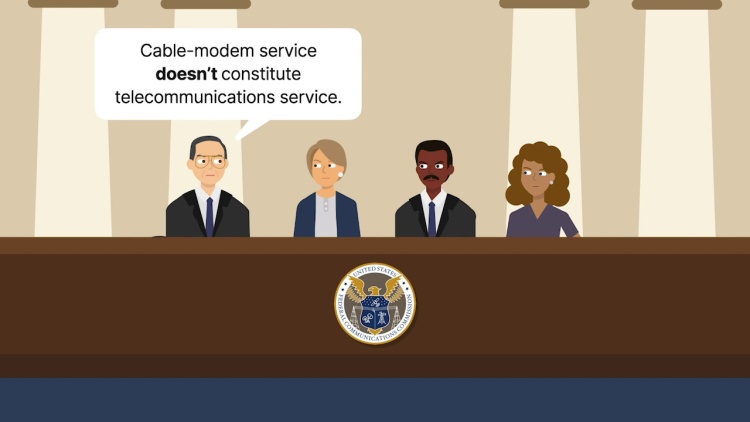National Cable & Telecommunications Association v. Brand X Internet Services
United States Supreme Court
545 U.S. 967, 125 S.Ct. 2688, 162 L.Ed.2d 820 (2002)

- Written by Eric Cervone, LLM
Facts
In the 1970s, the Federal Communications Commission (FCC) developed rules for regulating data processing over telephone wires. These rules separated data-processing services into basic service (which transmitted voice or similar plain-language communications without altering the text) and enhanced service (which included any data-processing activity that acted on the content, code, protocol, and other aspects of the subscriber’s information). Providers of basic services were subject to mandatory common-carrier rules, but providers of enhanced services were not. The Telecommunications Act of 1996 (act) established definitions for “telecommunications service,” which was similar to basic service, and “information service,” which was similar to enhanced service. Providers of telecommunications services were subject to the common-carrier rules, but providers of information services were not. In 2000, the FCC undertook a rulemaking process to determine whether the broadband cable internet service provided by cable companies should be classified as telecommunications service or information service. The FCC concluded in a 2002 decision that broadband cable-modem service was an information service and thus not subject to the common-carrier rules. The FCC had previously decided that digital-subscriber-lines (DSL) service, another type of broadband internet service, was basic telecommunications service. Several entities petitioned for review of the FCC’s cable-modem decision in the United States Court of Appeals for the Ninth Circuit. The Ninth Circuit vacated the FCC’s ruling in part because the FCC’s classification of cable-modem service as information service contradicted the Ninth Circuit’s previous holding in AT & T Corp. v. Portland, 216 F.3d 871 (9th Cir. 2000), in which the court held that cable-modem service was a telecommunications service. The United States Supreme Court granted certiorari.
Rule of Law
Issue
Holding and Reasoning (Thomas, J.)
Concurrence (Breyer, J.)
Dissent (Scalia, J.)
What to do next…
Here's why 899,000 law students have relied on our case briefs:
- Written by law professors and practitioners, not other law students. 47,000 briefs, keyed to 994 casebooks. Top-notch customer support.
- The right amount of information, includes the facts, issues, rule of law, holding and reasoning, and any concurrences and dissents.
- Access in your classes, works on your mobile and tablet. Massive library of related video lessons and high quality multiple-choice questions.
- Easy to use, uniform format for every case brief. Written in plain English, not in legalese. Our briefs summarize and simplify; they don’t just repeat the court’s language.






